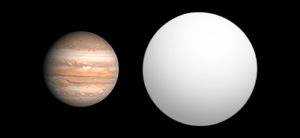HAT-P-8b
| Exoplanet | List of exoplanets | |
|---|---|---|
 | ||
| Parent star | ||
| Star | GSC 02757-01152 | |
| Constellation | Pegasus | |
| Right ascension | (α) | 22h 52m 09.8629s[1] |
| Declination | (δ) | +35° 26′ 49.605″[1] |
| Apparent magnitude | (mV) | 10.17 |
| Distance | 720±70[1] ly (220±20[1] pc) | |
| Orbital elements | ||
| Semi-major axis | (a) | 0.04496+0.00046 −0.00045[2] AU |
| Eccentricity | (e) | <0.0060[2] |
| Orbital period | (P) | 3.0763458±0.0000024[3] d |
| Inclination | (i) | 87.5+1.9 −0.9° |
| Time of transit | (Tt) | 2454437.6742±0.0014[3] JD |
| Physical characteristics | ||
| Mass | (m) | 1.354±0.035[2] MJ |
| Radius | (r) | 1.5+0.08 −0.06 RJ |
| Discovery information | ||
| Discovery date | December 5, 2008 | |
| Discoverer(s) | HATNet Project | |
| Discovery method | Transit | |
| Discovery status | Published[4] | |
| Database references | ||
| Extrasolar Planets Encyclopaedia | data | |
| SIMBAD | data | |
| Exoplanet Archive | data | |
| Open Exoplanet Catalogue | data | |
HAT-P-8b is an extrasolar planet located approximately 720 light years away in the constellation of Pegasus, orbiting the 10th magnitude star GSC 02757-01152. This planet was discovered by transit on December 5, 2008. Despite the designation as HAT-P-8b, it is the 11th planet discovered by the HATNet Project. The mass of the planet is 50% more than Jupiter while the radius is also 50% more than Jupiter. The mass of this planet is exact since the inclination of the orbit is known, typical for transiting planets. This is a so-called “hot Jupiter” because this Jupiter-like gas giant planet orbits in a really close torch orbit around the star, making this planet extremely hot (in the order of a thousand kelvins). The distance from the star is roughly 20 times smaller than that of Earth from the Sun, which places the planet roughly 8 times closer to its star than Mercury is from the Sun. The “year” on this planet lasts only 3 days, 1 hour, 49 minutes, and 54 seconds, compared with Earth's 365 days, 6 hours, 9 minutes, and 10 seconds in a sidereal year.[4]
References
- 1 2 3 4 Brown, A. G. A; et al. (2016). "Gaia Data Release 1. Summary of the astrometric, photometric, and survey properties". Astronomy and Astrophysics. 595. A2. arXiv:1609.04172. Bibcode:2016A&A...595A...2G. doi:10.1051/0004-6361/201629512. Gaia Data Release 1 catalog entry
- 1 2 3 Bonomo, A. S.; et al. (2017). "The GAPS Programme with HARPS-N at TNG . XIV. Investigating giant planet migration history via improved eccentricity and mass determination for 231 transiting planets". Astronomy and Astrophysics. 602. A107. arXiv:1704.00373. Bibcode:2017A&A...602A.107B. doi:10.1051/0004-6361/201629882.
- 1 2 Mancini, L.; et al. (2013). "A lower radius and mass for the transiting extrasolar planet HAT-P-8 b". Astronomy and Astrophysics. 551. A11. arXiv:1212.3701. Bibcode:2013A&A...551A..11M. doi:10.1051/0004-6361/201220291.
- 1 2 Latham, David W.; et al. (2009). "Discovery of a Transiting Planet and Eight Eclipsing Binaries in HATNet Field G205". The Astrophysical Journal. 704 (2): 1107–1119. arXiv:0812.1161. Bibcode:2009ApJ...704.1107L. doi:10.1088/0004-637X/704/2/1107.
External links
![]()
- "HAT-P-8b light curve using differential photometry". Exoplanets.
- "HAT-P-8 b". Exoplanets.